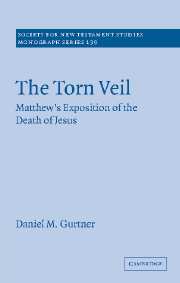Book contents
- Frontmatter
- Contents
- Preface
- List of abbreviations
- 1 Introduction
- 2 Veils in the Old Testament
- 3 Functionality and Identity of the ‘Veil of the Temple’
- 4 The Veil in Second Temple and Rabbinic Judaism
- 5 Matthew's Temple and Jesus' Death: Hermeneutical Keys to the Rending of the Veil
- 6 Analysis of the Matthean Velum Scissum Pericope
- Conclusion: Matthew's velum scissum – Retrospect and Prospect
- Diagram: Veil Language in the Structure of the Tabernacle
- Appendix 1 Veil Language in the Old Testament
- Appendix 2 Veil Language in the Two Tabernacle Accounts
- Appendix 3 Kαταπέτασμα and the חכרפ
- Bibliography
- Index of Texts
- Index of Select Subjects
- Index of Modern Authors
- Index of Select Terms
3 - Functionality and Identity of the ‘Veil of the Temple’
Published online by Cambridge University Press: 22 September 2009
- Frontmatter
- Contents
- Preface
- List of abbreviations
- 1 Introduction
- 2 Veils in the Old Testament
- 3 Functionality and Identity of the ‘Veil of the Temple’
- 4 The Veil in Second Temple and Rabbinic Judaism
- 5 Matthew's Temple and Jesus' Death: Hermeneutical Keys to the Rending of the Veil
- 6 Analysis of the Matthean Velum Scissum Pericope
- Conclusion: Matthew's velum scissum – Retrospect and Prospect
- Diagram: Veil Language in the Structure of the Tabernacle
- Appendix 1 Veil Language in the Old Testament
- Appendix 2 Veil Language in the Two Tabernacle Accounts
- Appendix 3 Kαταπέτασμα and the חכרפ
- Bibliography
- Index of Texts
- Index of Select Subjects
- Index of Modern Authors
- Index of Select Terms
Summary
Introduction
S. Jellicoe insisted that it is ‘primarily to the Greek Old Testament that we should look … for the theological significance of the terminology of the New (Testament)’. As we have seen, however, lexical evidence for which veil Matthew had in mind in his velum scissum, let alone what is meant by it, in itself is inconclusive since the LXX knows three curtains it translates καταπέτασμα. While syntactical evidence (the locative genitive) is much more helpful in identifying which of these curtains the evangelist had in mind, it is neither the only nor the most decisive means by which such a verdict regarding the identity of Matthew's veil and the significance of its rending can or should be made. As we have seen in the introduction, one of the few points of agreement among scholars who address the rending of the veil is that whatever else it means, it surely refers to the cessation of the veil's function. How did it function? If Matthew's term refers to the inner veil before the holy of holies, D. Senior claims it ‘signified the locus of God's presence at the heart of Israel's cultic life’ and ‘served as a wall of separation between the people and Yahweh, the “wholly other”’. C. Meyers says ‘it guarded the … Ark, from the profanity of contact with humans’. S. Motyer says it ‘is taken to embody the whole religious system of the Temple’.
- Type
- Chapter
- Information
- The Torn VeilMatthew's Exposition of the Death of Jesus, pp. 47 - 71Publisher: Cambridge University PressPrint publication year: 2006



